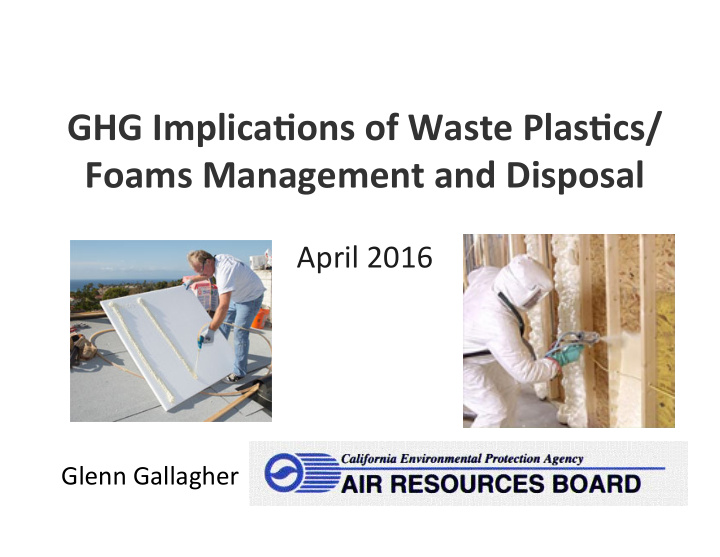



GHG ¡Implica+ons ¡of ¡Waste ¡Plas+cs/ Foams ¡Management ¡and ¡Disposal ¡ ¡ April ¡2016 ¡ Glenn ¡Gallagher ¡
Greenhouse Gas (GHG) Impacts • Plastics – relatively low • Open cell (flexible) foams – relatively low • Closed cell (rigid) insulating foams – very high due to fluorinated gases used as foam expansion agents; low GHG impact after landfilling 2 ¡
GHG Impacts by Metric Tonnes CO 2 - equivalents per short ton (2000 lbs.) Material Type – Recycling Combustion Landfilling Plastics and for energy Foam Plastics and Open Cell (flexible) -1.5 1.3 0.04 Foam (WARM Model) Closed Cell (rigid) 500–1,000 1.3 1.9* Insulating Foam (ARB estimates) * In landfills with methane capture and combustion systems (required in California) 3 ¡
Fluorinated ¡Gas ¡Emissions ¡in ¡CA, ¡2015 ¡ ¡ (8% ¡of ¡all ¡Greenhouse ¡Gas ¡Emissions) ¡ Solvents, ¡Fire ¡ Suppressants ¡ Insula+ng ¡ 1% ¡ Foam ¡ 14% ¡* ¡ Refrigerants ¡ Propellants ¡ 83% ¡ 2% ¡ ¡ 4 ¡ * ¡Insula+ng ¡Foam ¡ ¡ ¡̴ ¡1% ¡of ¡all ¡GHGs ¡(when ¡CO 2 , ¡etc., ¡incl.) ¡ ¡
Foam Expansion Agents BAU: ODS or High-GWP To 1994: CFCs – the ODS years - GWP 4750 1995-2009: HCFCs (ODS-lite) - GWP 725 2010-2020: HFCs – non-ODS but GWP 1030-1430 5 ¡
Foam Expansion Agents w/ New Regs: Non-ODS and Low-GWP • Beginning 2020, U.S. EPA regulations (SNAP Program) require low-GWP foam expansion agents • Low-GWP foam expansion agents used for decades (CO 2 /water, hydrocarbons), esp. flexible foam, but poor insulating value • New low-GWP hydrofluoro-olefins (HFOs) have good insulating value 6 ¡
Closed ¡Cell ¡Foam ¡GHG ¡Emissions ¡in ¡CA, ¡ 1990-‑2050 ¡ (million ¡metric ¡tonnes ¡CO 2 -‑equivalents) ¡ 10 ¡ ¡ Total ¡Foam ¡ 8 ¡ Greenhouse ¡Gases, ¡ Business ¡as ¡Usual ¡ 6 ¡ 4 ¡ Business ¡As ¡Usual ¡ *IPCC ¡Data ¡ 2 ¡ 0 ¡ 1990 ¡ 2000 ¡ 2010 ¡ 2020 ¡ 2030 ¡ 2040 ¡ 2050 ¡ 7 ¡
Closed ¡Cell ¡Foam ¡GHG ¡Emissions ¡in ¡CA, ¡ 1990-‑2050 ¡ (million ¡metric ¡tonnes ¡CO 2 -‑equivalents) ¡ 10 ¡ ¡ Total ¡Foam ¡ 8 ¡ Greenhouse ¡Gases, ¡ Business ¡as ¡Usual ¡ 6 ¡ Total ¡Foam ¡ Greenhouse ¡Gases ¡ 4 ¡ w/ ¡2015 ¡U.S. ¡EPA ¡ *IPCC ¡Data ¡ W/ ¡EPA ¡RegulaRons ¡ Regula+ons ¡ 2 ¡ 0 ¡ 1990 ¡ 2000 ¡ 2010 ¡ 2020 ¡ 2030 ¡ 2040 ¡ 2050 ¡ 8 ¡
Landfill Emissions from Waste Foam are Low (10% of previous est.) • 2016 Cal Poly San Luis Obispo study shows 99.5% of fluorinated gases in landfills are destroyed in methane gas collection & combustion systems • Emissions occur before end-of-life for building insulation by outgassing • Emissions occur at time of shredding/ recycling for appliances 9 ¡
Summary • GHGs from waste insulating foam high if shredded • GHGs are low after landfilling • Best practice is to leave building foam in large pieces, and cut appliance foam off in slabs • Incineration marginally better than landfilling (in landfills with methane capture) • 90% reductions in foam GHGs by 2050 10 ¡
Questions? Glenn.Gallagher@arb.ca.gov 11 ¡
Recommend
More recommend